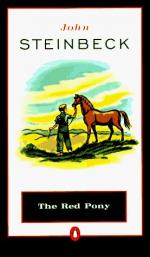|
This section contains 216 words (approx. 1 page at 400 words per page) |

|
A writer of great talent, sensitivity, and imagination, John Steinbeck entered into the mood of the country in the late 1930s with an extraordinary responsiveness. The Depression had elicited a reevaluation of American culture, a reassessment of the American dream; a harsh realism of observation was balanced by a warm emphasis on human dignity. Literature and the other arts joined social, economic, and political thought in contrasting traditional American ideals with the bleak reality of bread lines and shantytowns.
Perhaps the major symbol of dislocation was the Dust Bowl. The American garden became a wasteland from which its dispossessed farmers fled. The arts in the 1930s focused on these harsh images and tried to find in them the human dimensions which promised a new beginning.
Incidents such as the killing of the mare in The Red Pony are powerful and may upset young readers. But few...
|
This section contains 216 words (approx. 1 page at 400 words per page) |

|




